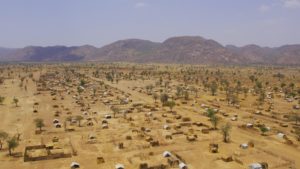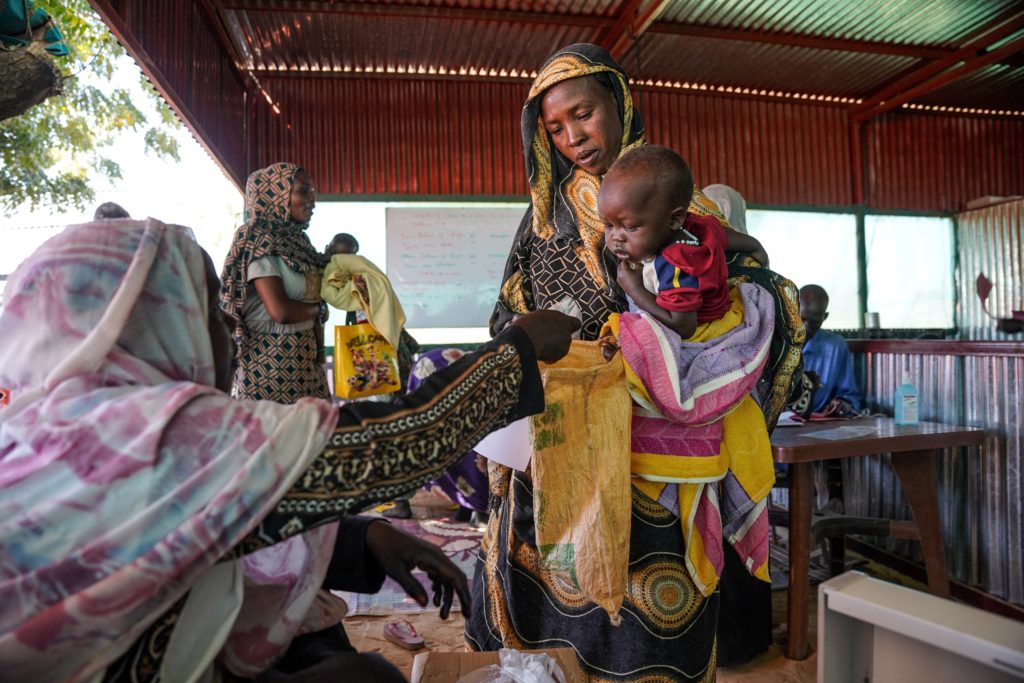Mother of Mercy Hospital is in Sudan’s Nuba Mountains, somewhat distant from fighting in other parts of the country. But every day, it witnesses the devastation wrought by Sudan’s ongoing civil war.
The hunger is “terrible,” said Sister Anita Cecilia, a Comboni Missionary from Uganda who is an administrator at Mother of Mercy. “It’s all over.”
The hospital, founded in 2008, is in the town of Gidel, in the southern part of Sudan. Because it is relatively peaceful, refugees from all parts of the country have been flooding into the area, driven from their homes by conflict and hunger. Since the war began on April 15, 2023, the local population has at least tripled.
The Nuba Mountains area, which remained part of Sudan after South Sudan became independent in 2011, is ill-prepared to help anybody, affected by the same shortages that the rest of the country is experiencing. Because of the war, crops have not been harvested and fields have not been sown in Sudan. Sister Anita said that next year’s crop of the local staple sorghum is expected to be even poorer than this year’s. Up to 3 million people are at risk of famine in the region.
What little food is available has become prohibitively expensive for most people, she said. “Prices in the market have skyrocketed.”
Meanwhile, the conflict between two factions of Sudan’s military government is also preventing the influx of vital humanitarian aid. Last month, The New York Times detailed how the government, suspecting arms smuggling, has largely blocked UN aid convoys at border crossings into Sudan. Earlier this month, famine was officially declared in Darfur, a region of Sudan the size of Spain.
To make things even more complicated, humanitarian agencies said that international funding for relief programs is inadequate, despite warnings that the famine in Sudan could rival the disaster in Ethiopia in the 1980s.

“Hunger is deepening in Sudan and in neighboring countries to which millions of people have fled, creating a hunger crisis that could become the world’s largest,” the World Food Programme (WFP) reported in June.
“Sudan is in the grip of widespread hunger and malnutrition,” said Michael Dunford, WFP’s regional director for Eastern Africa. “The situation is already catastrophic and has the potential to worsen further unless support reaches all those affected by conflict.”
In early June, Dr. Tom Catena, chief medical officer at Mother of Mercy, told Angelus that while there normally might be half a dozen children in the hospital’s malnutrition unit, he was treating upwards of 30 at a time. Some with underlying conditions such as pneumonia, tuberculosis, and diarrhea, so far gone by the time they arrived at the hospital … were so bad that they could not be saved.
Any glimmers of hope left in Sudan today, it seems, are found in the work of people like Sister Anita and Dr. Catena.
The world’s biggest displacement crisis
Sudan was Africa’s largest country by area until South Sudan’s secession in 2011 (now it is the third). After independence from Great Britain and Egypt in 1956, a new government began Islamist rule, exacerbating a rift between an Islamic north and a Christian and animist south.
Civil war ensued. Between 1989 and 2019, dictator Omar al-Bashir ruled the country, overseeing ethnic genocide in the western Darfur provinces and other human rights abuses. A 2019 coup resulted in Bashir’s imprisonment.
Islamic law was applied from 1983 until 2020, when Sudan became a secular state.
The most intense fighting has come in the last 13 months after a split between the Sudan Armed Forces (SAF), led by General Abdel Fattah al-Burhan, the country’s de facto ruler, and a paramilitary organization known as the Rapid Support Forces (RSF). The RSF grew out of the Janjaweed that al-Bashir had relied on in the 2000s to suppress a rebellion in Darfur and is led by General Mohammed Hamdan Dagalo, better known as “Hemedti.”
The movement of refugees seeking food, medicine, and shelter is unlike anything seen in modern history. A report in July from the International Organization on Migration (IOM) claimed there are 10.6 million internally displaced persons in Sudan. The IOM said over 2.2 million people crossed borders from Sudan into neighboring countries, with the majority heading into Chad (about 813,000), South Sudan (752,000) and Egypt (515,000).

Bishop Stephen Nyodho Ador sees the crisis unfolding daily in his Diocese of Malakal, South Sudan. Just a couple of years after it won independence, South Sudan was embroiled in a civil war of its own, and many South Sudanese fled north, to Sudan, to escape harsh conditions. Now, many are returning.
Malakal is on the border with Sudan, and three parishes are “greatly involved in this reception of the refugees and returnees,” Ador told Angelus.
A diocese-owned boat ferries refugees along the White Nile from Renk, near the border with Sudan, to Malakal. Renk is the only official entry point allowed by the government of South Sudan.
Ador said the diocese was not prepared for such an influx in the beginning of the current war, but with the help of partners such as Caritas and the U.S.-based Sudan Relief Fund, it has been able to provide daily rations for refugees.
The diocese, along with Jesuit Relief Services (JRS), also is assisting at the Maban refugee camp near Malakal. JRS provides training for teachers, school materials, day care for disabled children, home visits, counseling, psychosocial support, and emergency assistance. It coordinates social centers for refugee women while providing opportunities to learn tailoring and life skills.
Three priests serve in the refugee camp and offer Mass for Catholic refugees. The presence of priests and religious with the refugees is a “concrete sign of hope for the desperate people of God,” Bishop Ador said.
Sudan is only about 4% Catholic, but the Church is seen as an important institution, with priests, brothers, and sisters very active in education. The Comboni Missionaries run a large university in Khartoum, the capital.
“When the war broke out, people ran to knock on the door of the Church because they knew they were there to help others,” said Kinga Schierstaedt, a team leader for Africa at Aid to the Church in Need. “The problem was that this war took the Church itself by surprise, so they didn’t have any food or water supplies — nothing. They were actually in the same situation as the people who ran to them for help.”
Schierstaedt said that Aid to the Church in Need, a pontifical foundation with headquarters in Germany, is ready to help financially, but it’s impossible to get money or material aid into the country.
Hell on earth
Ador finds it difficult to express with words the suffering he sees.
“The life of the innocent people has become so miserable; it is a hell on earth,” he said.
“Imagine a person who was earning his or her living happily, planning well for the future of his or her family, a person who has been living in a beautiful house, having a good job but then finding himself or herself a refugee in another country, or internally displaced and unable to get a single meal per day, or even a shelter for the family.” People with chronic diseases now find themselves without any medical attention, and people in pain are unable to get painkillers.
“Their only hope is the mercy of God,” the bishop said.

The Church, with only two Roman Catholic dioceses and most parishes closed, depends almost entirely on outside help to keep that hope alive.
“Many churches and Church institutions have been looted and destroyed,” Ador said. “Almost all the priests and religious men and women fled the country as the situation became unbearable.”
The 51-year-old Ador said the Church’s role in the crisis is to encourage dialogue and “entrust the situation to Divine Providence, but also to lobby with the international community to assist the Sudanese factions to reach a peaceful settlement.”
“The Church is able to call upon the international community to make sure that the people of Sudan are not forgotten, therefore, to lobby for humanitarian assistance. Sudan has a prominent place in Africa, therefore, peace in Sudan is peace in the region.”
For Ador, Pope Francis’ visit to South Sudan last year brought “a message of hope, that at the end of the tunnel there will always be the light.”
Today, the Church in Sudan relies on material support from Catholics in other countries as a “sign of solidarity and love for the suffering body of Christ in the persons of the refugees and the displaced,” in the words of Ador.
Despite the heavy burden, the Diocese of Malakal will continue aiding the waves of people coming into this part of South Sudan.
“It’s not the role of the diocese to do that,” said Ador. “But you cannot close your eyes when someone is dying near you.”

How to help those suffering in war-torn Sudan
Here are some of the Catholic humanitarian organizations currently working to provide food, medicine, shelter, and other basic needs to refugees in both Sudan and South Sudan.

